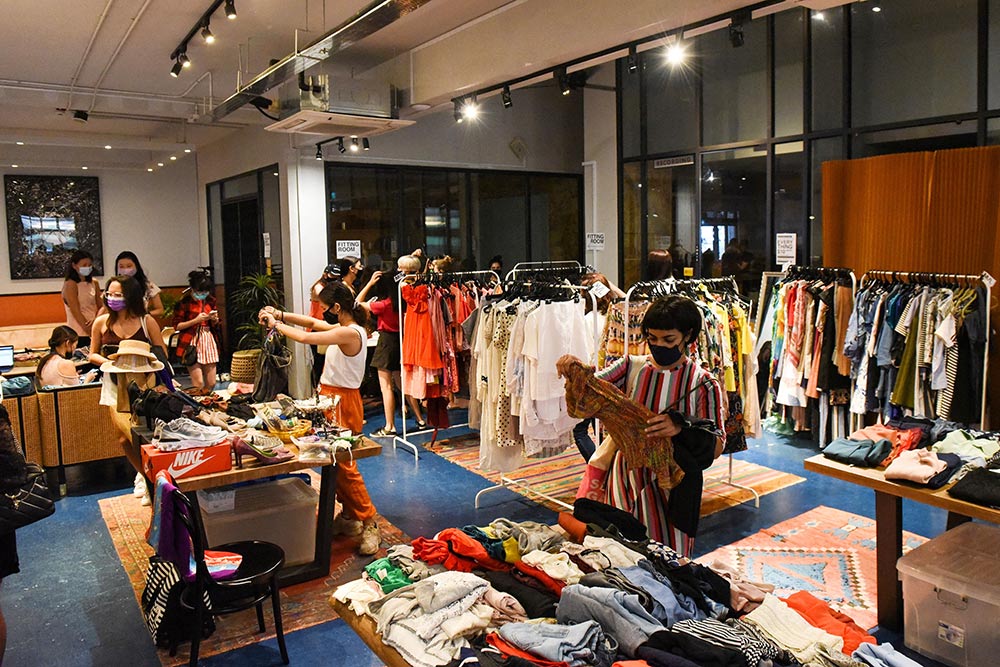
經(jīng)過18個(gè)月的居家隔離,在重新開啟新生活之際,你是否想要重新打造自己的衣柜?此時(shí),二手服裝店或許正是你的最佳選擇。
在“居家令”解除之后,美國人紛紛清理起了自己的衣柜,二手交易隨之迎來爆發(fā)。根據(jù)二手服裝寄售網(wǎng)站ThredUp和全球知名數(shù)據(jù)分析和咨詢公司Global Data的報(bào)告,預(yù)計(jì)到2025年,二手服裝的銷售額將實(shí)現(xiàn)翻番,從360億美元增長至770億美元。這相當(dāng)于服裝行業(yè)整體增速的11倍之多。
與此同時(shí),愿意出售自己舊衣物的人數(shù)也在增加。調(diào)查發(fā)現(xiàn),去年的賣家總數(shù)為5260萬,其中69%為首次出售的新賣家。據(jù)預(yù)計(jì),賣家總數(shù)還將增加一倍以上。
據(jù)ThredUP估計(jì),消費(fèi)者的衣櫥中大約閑置著90億件幾乎全新的服裝。而二手商店的蓬勃發(fā)展也在改變?nèi)藗儯▽Χ之a(chǎn)品)的看法。對ThredUp、Poshmark、Plto’s Closet、Maven Vintage、Buffalo Exchange,甚至北美最大的慈善舊貨店GoodWill等企業(yè)而言,這無疑是一條絕佳消息。
不僅賣家數(shù)量大幅增加,去年首次購買二手服裝的人數(shù)也增加了3300萬,其中四分之三的人表示自己計(jì)劃增加在二手市場的支出。調(diào)查顯示,總計(jì)約有2.23億消費(fèi)者愿意購買二手產(chǎn)品。
消費(fèi)者選擇購買二手產(chǎn)品的原因各不相同,有些是出于環(huán)境和可持續(xù)發(fā)展的考慮,有些則是因?yàn)槎置飘a(chǎn)品的價(jià)格遠(yuǎn)低于新品價(jià)格。此外,在二手服裝店購物還會(huì)有一種“淘寶”的快感。對賣家而言,這也是清理長期積累的或圍繞在他們身邊的各種雜物的絕佳機(jī)會(huì)。(財(cái)富中文網(wǎng))
譯者:梁宇
審校:夏林
經(jīng)過18個(gè)月的居家隔離,在重新開啟新生活之際,你是否想要重新打造自己的衣柜?此時(shí),二手服裝店或許正是你的最佳選擇。
在“居家令”解除之后,美國人紛紛清理起了自己的衣柜,二手交易隨之迎來爆發(fā)。根據(jù)二手服裝寄售網(wǎng)站ThredUp和全球知名數(shù)據(jù)分析和咨詢公司Global Data的報(bào)告,預(yù)計(jì)到2025年,二手服裝的銷售額將實(shí)現(xiàn)翻番,從360億美元增長至770億美元。這相當(dāng)于服裝行業(yè)整體增速的11倍之多。
與此同時(shí),愿意出售自己舊衣物的人數(shù)也在增加。調(diào)查發(fā)現(xiàn),去年的賣家總數(shù)為5260萬,其中69%為首次出售的新賣家。據(jù)預(yù)計(jì),賣家總數(shù)還將增加一倍以上。
據(jù)ThredUP估計(jì),消費(fèi)者的衣櫥中大約閑置著90億件幾乎全新的服裝。而二手商店的蓬勃發(fā)展也在改變?nèi)藗儯▽Χ之a(chǎn)品)的看法。對ThredUp、Poshmark、Plto’s Closet、Maven Vintage、Buffalo Exchange,甚至北美最大的慈善舊貨店GoodWill等企業(yè)而言,這無疑是一條絕佳消息。
不僅賣家數(shù)量大幅增加,去年首次購買二手服裝的人數(shù)也增加了3300萬,其中四分之三的人表示自己計(jì)劃增加在二手市場的支出。調(diào)查顯示,總計(jì)約有2.23億消費(fèi)者愿意購買二手產(chǎn)品。
消費(fèi)者選擇購買二手產(chǎn)品的原因各不相同,有些是出于環(huán)境和可持續(xù)發(fā)展的考慮,有些則是因?yàn)槎置飘a(chǎn)品的價(jià)格遠(yuǎn)低于新品價(jià)格。此外,在二手服裝店購物還會(huì)有一種“淘寶”的快感。對賣家而言,這也是清理長期積累的或圍繞在他們身邊的各種雜物的絕佳機(jī)會(huì)。(財(cái)富中文網(wǎng))
譯者:梁宇
審校:夏林
Looking to shake up your wardrobe as you emerge from 18 months of isolation? The best bargain might be at a secondhand clothing shop.
Americans are purging their closets as they emerge from stay-at-home orders and that’s resulting in a surge of business for resellers. The secondhand clothing business is expected to see sales double from $36 billion to $77 billion by 2025, according to a report from ThredUp and Global Data. That’s 11 times faster than the broader clothing sector.
The number of people open to selling their used clothes is on the rise as well. The study found there were 52.6 million total sellers last year – with 69% of those being first time sellers. And the total number of sellers is expected to more than double.
ThredUp estimates there are 9 billion hardly-worn clothing items sitting in shoppers’ closets. And the growing market for thrift stores is adjusting people’s mindsets. That’s good news for companies like ThredUp, Poshmark, Plato’s Closet, Maeven Vintage, Buffalo Exchange and even Goodwill.
It’s not just sellers. The number of first-time buyers of secondhand clothes jumped by 33 million last year – and three-quarters of them plan to increase their spending in that market. All totaled, some 223 million consumers are open to secondhand shopping, says the survey.
The reasons vary, from environmental and sustainability factors to dramatically lower prices for name-brand items. There’s also a thrill of the hunt aspect to shopping in secondhand clothing stores. And for sellers, it’s a good chance to rid themselves of the clutter they’ve accumulated or been surrounded by since last March.






